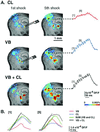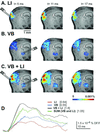Temporal binding via cortical coincidence detection of specific and nonspecific thalamocortical inputs: a voltage-dependent dye-imaging study in mouse brain slices
- PMID: 11773628
- PMCID: PMC117580
- DOI: 10.1073/pnas.012604899
Temporal binding via cortical coincidence detection of specific and nonspecific thalamocortical inputs: a voltage-dependent dye-imaging study in mouse brain slices
Abstract
Voltage-sensitive dye imaging of mouse thalamocortical slices demonstrated that electrical stimulation of the centrolateral intralaminar thalamic nucleus (CL) resulted in the specific activation of thalamic reticular nucleus, striatum/putamen, and cortical layers 5, 6, and 1. By contrast, ventrobasal (VB) thalamic stimulation, while activating the reticular and basal ganglia nuclei, also activated directly layers 4 and deep 5 of the cortex. Conjoined stimulation of the VB and CL nuclei resulted in supralinear summation of the two inputs at cortical output layer 5, demonstrating coincidence detection along the apical dendrites. This supralinear summation was also noticed at gamma band stimulus frequency ( approximately 40 Hz). Direct stimulation of cortical layer 1, after a radial section of the cortex that spared only that layer, was shown to sum supralinearly with the cortical activation triggered by VB stimulation, providing a second demonstration for coincidence detection. Coincidence detection by coactivation of the specific (VB) and nonspecific (CL) thalamic nuclei has been proposed as the basis for the temporal conjunction that supports cognitive binding in the brain.
Figures





References
-
- Crick F, Koch C. Cold Spring Harbor Symp Quant Biol. 1990;55:953–962. - PubMed
-
- Eckhorn R, Bauer R, Jordan W, Brosch M, Kruse W, Munk M, Reitbock H J. Biol Cybern. 1988;60:121–130. - PubMed
-
- Gray C M, Konig P, Singer W. Nature (London) 1989;338:334–337. - PubMed
-
- Llinás R. In: Fidia Research Foundation Neuroscience Award Lectures. Changeux J-P, Llinás R R, Purves D, Bloom F, editors. Vol. 4. New York: Raven; 1990. pp. 1–10.
Publication types
MeSH terms
Grants and funding
LinkOut - more resources
Full Text Sources
Other Literature Sources

